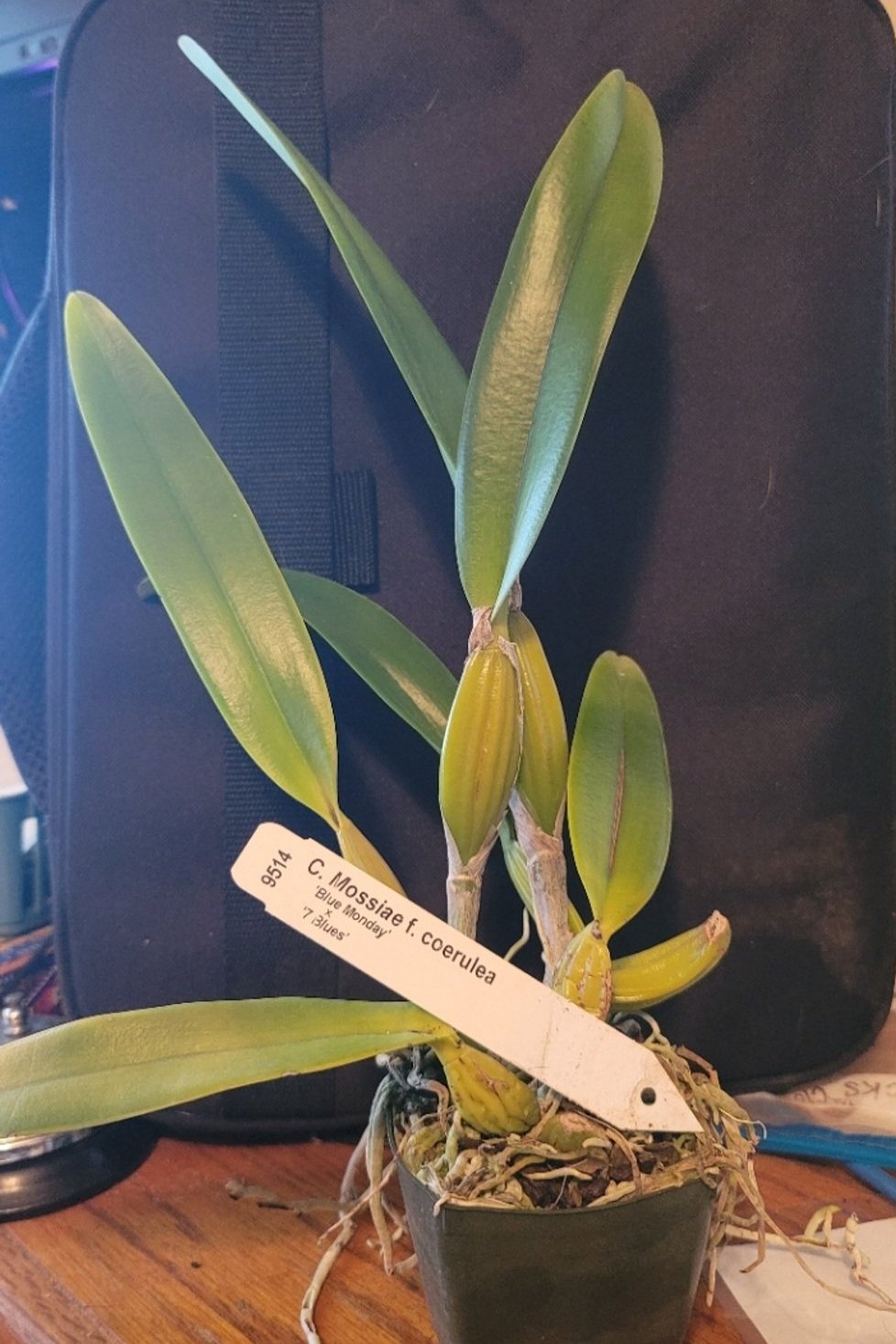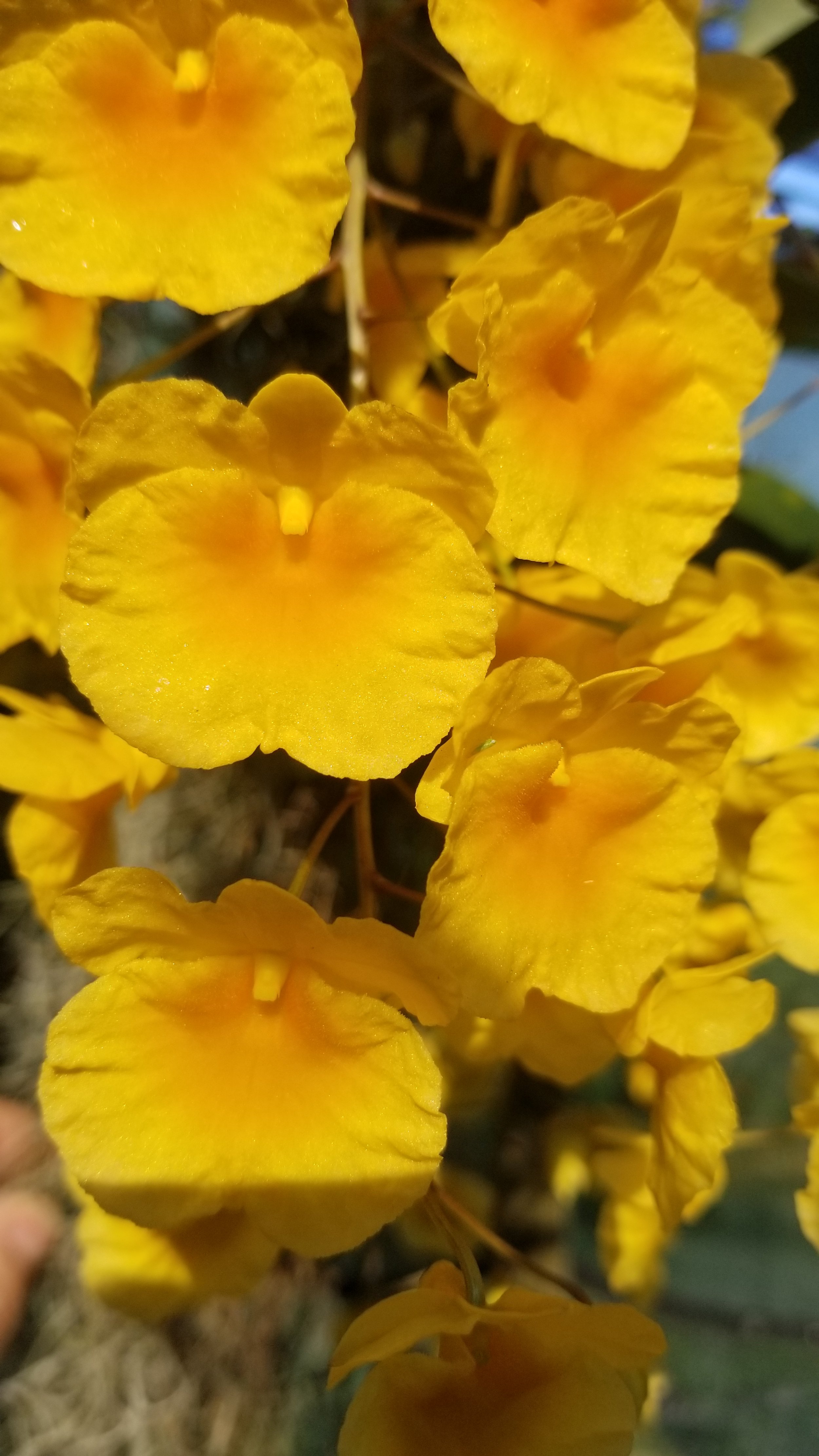 Image 1 of 2
Image 1 of 2

 Image 2 of 2
Image 2 of 2



Cattleya mossiae f. coerulea
Cattleya mossiae f. coerulea
Cattleya mossiae was first described by William Jackson Hooker in 1839. The coerulea form (from Latin "caeruleus," meaning blue) is a naturally occurring variant with blue-toned flowers, distinguished from the species’ typical lavender-pink coloration. Known as the "Easter Orchid" or “Mother’s Day Orchid” due to its spring blooming. The species is endemic and the national flower to Venezuela, growing at elevations of 800-1,800 meters. Our plants are well established, blooming size (4in pots) and fully acclimated to outdoor growing in South Florida.
Appearance
Plant Structure:
A unifoliate epiphyte with stout, elongated pseudobulbs (15-30 cm tall), each bearing a leathery leaf (15-25 cm long, oblong, and dark green).
Growth habit is upright and robust, typical of large-flowered Cattleya species.
Flowers:
Size: Large, 15-20 cm (6-8 inches) across, among the most impressive in the genus.
Color: In the f. coerulea form, petals and sepals are pale bluish-lavender to soft lilac, often with a subtle grayish or silvery undertone. The lip is a deeper blue-violet, sometimes with faint yellow or greenish-yellow markings in the throat—a vestige of the species’ typical coloration. This contrasts with the standard C. mossiae, which has rich lavender-pink petals and a darker magenta lip with a yellow center.
Shape: Broad, rounded petals and sepals with a prominent, ruffled lip that’s tubular at the base and flares out widely—a classic Cattleya silhouette.
Count: 2-5 flowers per inflorescence, emerging from a terminal sheath on new growths.
Fragrance: Strongly fragrant, with a sweet, floral scent reminiscent of lilac, rose, or honey. The coerulea form retains this delightful aroma, a key trait of C. mossiae.
Comparison to Typical Cattleya mossiae
Standard Form: Lavender-pink to rose petals and sepals, with a vivid magenta-purple lip and bright yellow throat.
F. coerulea: A genetic variant with reduced anthocyanin pigments (responsible for pink/purple), resulting in blue tones. This is a natural mutation, not a hybrid, and is rarer in the wild and cultivation.
Cattleya mossiae f. coerulea
Cattleya mossiae was first described by William Jackson Hooker in 1839. The coerulea form (from Latin "caeruleus," meaning blue) is a naturally occurring variant with blue-toned flowers, distinguished from the species’ typical lavender-pink coloration. Known as the "Easter Orchid" or “Mother’s Day Orchid” due to its spring blooming. The species is endemic and the national flower to Venezuela, growing at elevations of 800-1,800 meters. Our plants are well established, blooming size (4in pots) and fully acclimated to outdoor growing in South Florida.
Appearance
Plant Structure:
A unifoliate epiphyte with stout, elongated pseudobulbs (15-30 cm tall), each bearing a leathery leaf (15-25 cm long, oblong, and dark green).
Growth habit is upright and robust, typical of large-flowered Cattleya species.
Flowers:
Size: Large, 15-20 cm (6-8 inches) across, among the most impressive in the genus.
Color: In the f. coerulea form, petals and sepals are pale bluish-lavender to soft lilac, often with a subtle grayish or silvery undertone. The lip is a deeper blue-violet, sometimes with faint yellow or greenish-yellow markings in the throat—a vestige of the species’ typical coloration. This contrasts with the standard C. mossiae, which has rich lavender-pink petals and a darker magenta lip with a yellow center.
Shape: Broad, rounded petals and sepals with a prominent, ruffled lip that’s tubular at the base and flares out widely—a classic Cattleya silhouette.
Count: 2-5 flowers per inflorescence, emerging from a terminal sheath on new growths.
Fragrance: Strongly fragrant, with a sweet, floral scent reminiscent of lilac, rose, or honey. The coerulea form retains this delightful aroma, a key trait of C. mossiae.
Comparison to Typical Cattleya mossiae
Standard Form: Lavender-pink to rose petals and sepals, with a vivid magenta-purple lip and bright yellow throat.
F. coerulea: A genetic variant with reduced anthocyanin pigments (responsible for pink/purple), resulting in blue tones. This is a natural mutation, not a hybrid, and is rarer in the wild and cultivation.
Cattleya mossiae f. coerulea
Cattleya mossiae was first described by William Jackson Hooker in 1839. The coerulea form (from Latin "caeruleus," meaning blue) is a naturally occurring variant with blue-toned flowers, distinguished from the species’ typical lavender-pink coloration. Known as the "Easter Orchid" or “Mother’s Day Orchid” due to its spring blooming. The species is endemic and the national flower to Venezuela, growing at elevations of 800-1,800 meters. Our plants are well established, blooming size (4in pots) and fully acclimated to outdoor growing in South Florida.
Appearance
Plant Structure:
A unifoliate epiphyte with stout, elongated pseudobulbs (15-30 cm tall), each bearing a leathery leaf (15-25 cm long, oblong, and dark green).
Growth habit is upright and robust, typical of large-flowered Cattleya species.
Flowers:
Size: Large, 15-20 cm (6-8 inches) across, among the most impressive in the genus.
Color: In the f. coerulea form, petals and sepals are pale bluish-lavender to soft lilac, often with a subtle grayish or silvery undertone. The lip is a deeper blue-violet, sometimes with faint yellow or greenish-yellow markings in the throat—a vestige of the species’ typical coloration. This contrasts with the standard C. mossiae, which has rich lavender-pink petals and a darker magenta lip with a yellow center.
Shape: Broad, rounded petals and sepals with a prominent, ruffled lip that’s tubular at the base and flares out widely—a classic Cattleya silhouette.
Count: 2-5 flowers per inflorescence, emerging from a terminal sheath on new growths.
Fragrance: Strongly fragrant, with a sweet, floral scent reminiscent of lilac, rose, or honey. The coerulea form retains this delightful aroma, a key trait of C. mossiae.
Comparison to Typical Cattleya mossiae
Standard Form: Lavender-pink to rose petals and sepals, with a vivid magenta-purple lip and bright yellow throat.
F. coerulea: A genetic variant with reduced anthocyanin pigments (responsible for pink/purple), resulting in blue tones. This is a natural mutation, not a hybrid, and is rarer in the wild and cultivation.
Growing Conditions
Light: Bright, indirect light (2,500-3,500 foot-candles). Morning sun or filtered light is ideal, too little delays blooming.
Temperature: Intermediate, 55°F-85°F (13°C-29°C). Tolerates cooler nights (50°F/10°C) during winter rest.
Humidity: 50%-70%. Higher humidity supports growth, especially in summer.
Watering: Water when the medium (coarse bark or mounted) dries—weekly in summer, less in winter during dormancy. Avoid water in sheaths to prevent rot.
Fertilizer: Weekly 1/2 strength orchid fertilizer (e.g., 20-20-20) during growth (spring-summer), reduced in fall-winter.
Blooming
Season: Spring (April-May in the Northern Hemisphere), earning its "Easter Orchid" nickname. Blooming peaks around now—March 14, 2025—might catch late flowers in some climates.
Trigger: A dry rest in late winter (reduced watering after pseudobulbs mature) followed by increased light and water as new growths emerge.
Duration: Flowers last 2-4 weeks, longer in cooler, humid conditions.
Unique Traits
Blue Rarity: The coerulea form is scarce, prized for its unusual cool tones in a genus dominated by pinks, purples, and whites. True blue is rare in orchids, making this a standout.
Fragrance: Retains C. mossiae’s strong scent, unlike some coerulea forms of other species that lose fragrance with pigmentation changes.
Historical Appeal: C. mossiae was a Victorian-era favorite, and coerulea adds a modern twist to its legacy.
Care Tips
Potting: Use medium to coarse bark or mount on cork/wood for drainage and air exposure. Repot post-blooming when new roots appear.
Rest Period: Essential for flowering—reduce water in winter, resuming with spring growth.
Pests: Monitor for scale or spider mites, typical Cattleya pests, though not unusually susceptible.






